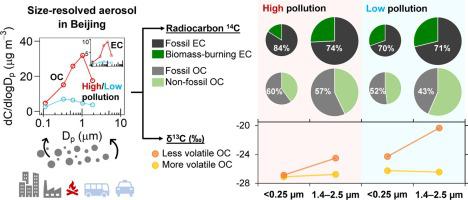Environment International ( IF 11.8 ) Pub Date : 2021-10-01 , DOI: 10.1016/j.envint.2021.106890 Haiyan Ni 1 , Ru-Jin Huang 2 , Peng Yao 3 , Max M Cosijn 3 , Norbertas Kairys 3 , Haobin Zhong 4 , Ulrike Dusek 3

|
This study investigates the sources and atmospheric processes of size-resolved carbonaceous aerosols in winter 2018 in urban Beijing, based on analysis of dual-carbon isotopes (i.e., radiocarbon and the stable isotope 13C). We found a size dependence of fossil source contributions to elemental carbon (EC), but no clear size dependence for organic carbon (OC). Comparable fossil source contributions to water-insoluble OC (WIOC; 55 ± 3%) and to water-soluble OC (WSOC; 54 ± 4%) highlight the importance of secondary aerosol formation, considering that fossil sources emit only small amounts of primary WSOC. OC concentrations increased during high PM2.5 pollution events, with increased fossil and non-fossil WSOC concentrating at larger particles (0.44–2.5 µm) than WIOC (0.25–2.5 µm), highlighting the aqueous-phase chemistry as an important pathway for OC production. The ratio of 13C/12C (expressed as δ13C) of total carbon (−27.0‰ to −23.3‰) fell in the range of anthropogenic aerosol, reflecting small biogenic influence. δ13C of OC increased with desorption temperature steps (200 °C, 350 °C and 650 °C). The strongly enriched δ13COC,650 (−26.9‰ to −20.3‰) and large mass fraction of OC650°C in total desorbed OC, both increasing with the increase of particle sizes, were caused by photochemical aging, especially during low and moderate PM2.5 pollution events, when regional, aged aerosol played an important role. During low pollution events, higher δ13COC,650 and WSOC/OC ratios reflect a larger contribution and more extensive chemical processing of aged aerosol. In contrast, relatively low δ13COC,200 (−27.2‰ to −25.7‰) suggests the influence of secondary OC formation on the more volatile OC desorbed at 200 °C. δ13COC,200 was similar for all particle sizes and for different pollution events, pointing to an internal mixture of local and aged regional OC. Our results show that the organic aerosol in Beijing arises from a mixture of various sources and complex formation processes, spanning local to regional scales. Particle sizes < 250 nm show strong contribution from local secondary OC formation, whereas refractory OC in particles around 1 µm shows strong evidence for regional aging processes. In summary, primary emission, secondary and aqueous-phase formation, and (photo-)chemical aging all need to be considered to understand organic aerosol in this region and their importance varies with particle size.



























 京公网安备 11010802027423号
京公网安备 11010802027423号